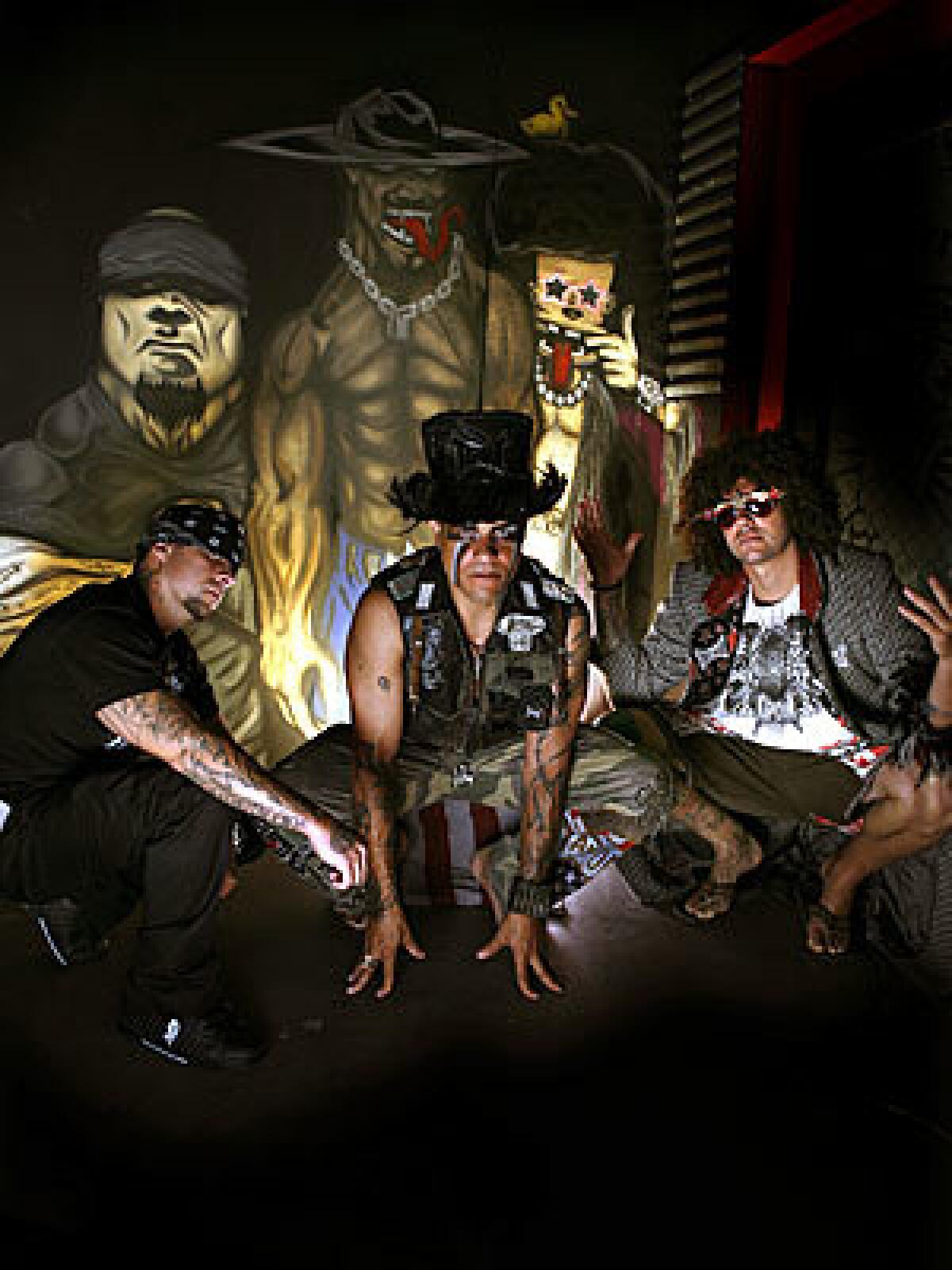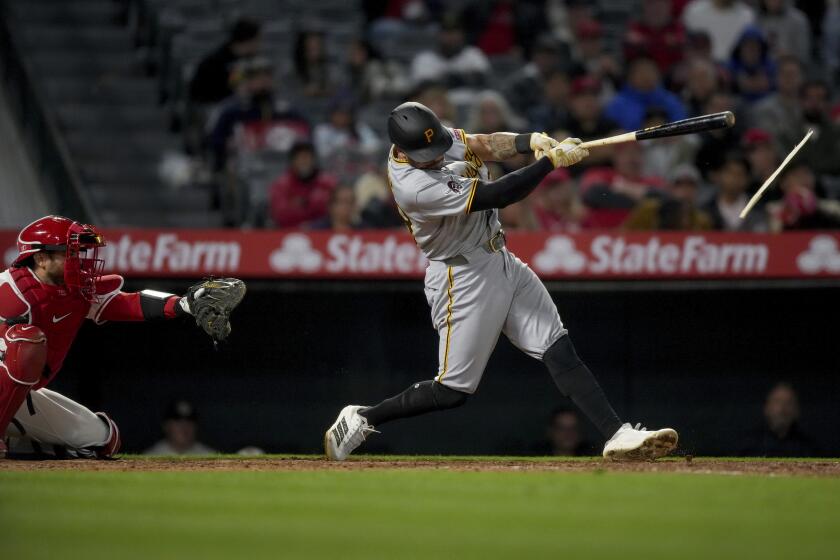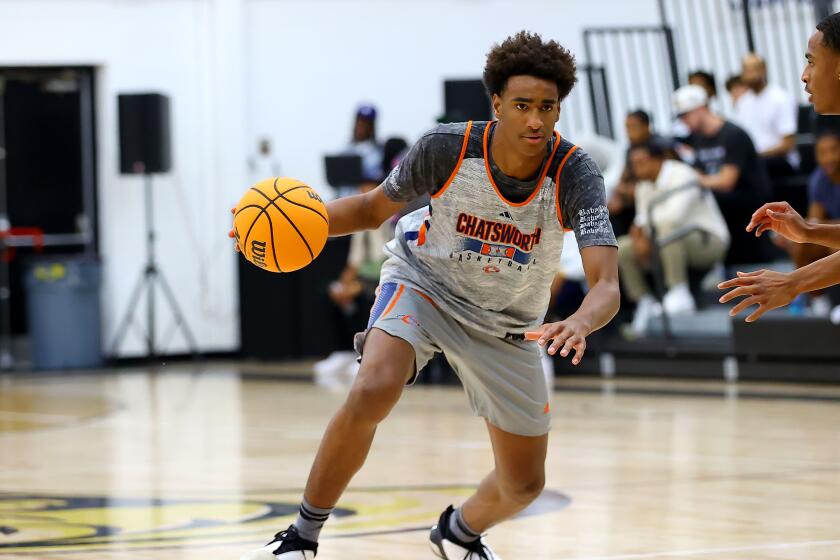As cage fighting’s popularity grows, Tapout label no longer battles for recognition

- Share via
THIRTY-SEVEN seconds after the opening bell, the “cage fighting” match between Brock “the Brainerd Brawler” Larson and Carlos Prater was over. A flurry of punches had left Prater motionless on the mat, his head lolling to one side and a trickle of blood escaping from the right corner of his mouth. Larson took a victory lap around the chain-link enclosure, smiling and pumping his fists to the cheers of the crowd.
It was hardly the kind of scene that makes one want to buy an infant onesie.
But mixed martial arts (MMA), a high-adrenaline fight format that’s illegal in 18 states, is not just a sport, it’s a lifestyle, and it’s quickly becoming the kind of branding magnet that has the potential to attract most every slice of the pop-culture pie -- from barroom brawlers to new parents. Once described by U.S. Sen. John McCain as “human cockfighting,” it’s the fastest-growing sport in the country, a billion-dollar business and pay-per-view darling that consistently pulls in the coveted 18-to-34 demographic. For its June prime-time network debut on CBS, more than 3 million households tuned in.
Like other athletes, MMA fighters are sponsored by clothing companies, and many of those companies are based in Southern California. Now, after a decade of selling fight shorts and T-shirts, they’re moving into bottled water, blue jeans and baby clothes in a bid to establish MMA as a lifestyle juggernaut alongside the surf and skate cultures that began here before going global.
It’s a long way, though, from the idyllic left-coast fantasy of laid-back kids communing with the waves or wheeling through concrete canyons. Mixed martial arts, which combines the moves of wrestling, boxing, kickboxing, judo, jujitsu and other fighting styles, is often played in an eight-sided ring (called an octagon) that’s enclosed by chain-link fencing or netting (thus the common references to it as cage fighting).
Participants, barefoot and wearing only fight shorts and padded 4- to 6-ounce fingerless gloves, were governed at first by only the barest of guidelines -- no eye-gouging or biting, but you might well take a kick to the head. The outlaw sport’s first blip on America’s pop-culture radar came in 1993 with the first tournament of its major fight league, the Ultimate Fighting Championship, and it quickly earned a reputation as an anything-goes, bar-brawl spectacle.
The UFC now has rules, weight classes and a fight format of three 15-minute rounds. To date 32 states have sanctioned MMA bouts; California, epicenter of the MMA business boom, didn’t see its first sanctioned fight until 2006.
How did a sport that still retains a bloody, street-tough edge manage to rocket beyond its core fan base to sell belt buckles, backpacks, boots and a lifestyle fantasy to millions of consumers?
Part of the answer lies in an industrial mini-mall 70 miles east of Los Angeles, home base for Tapout, a pioneering MMA lifestyle brand that boasts a clothing line, magazine, reality TV show and an ever-growing array of products. The faces of the brand are the Tapout crew, a trio of cartoonish clown princes with the kind of outsized personas familiar to fans of WWE wrestling. Their leader, Tapout’s founder and chief executive, who goes by the name of Mask (he was born Charles Lewis Jr.). On this mid-August day, he wears a camouflage cut-off shirt and matching floppy-brimmed military hat, and his face is streaked with black and gray stripes of paint.
Mask, taking a break from driving a massive RV around the country looking for up-and-coming fighters (part of the reality show, now in its second season on the cable TV sports channel Versus), sits in a dark conference room flanked by his cohorts. Punkass (a.k.a. Dan Caldwell, the company’s vice president) is in a Tapout T-shirt, arms full of tattoos and a blue paisley bandanna pulled down over his eyes, and SkySkrape (who refuses to divulge his birth name), has a huge, unruly afro that seems as fake as his moniker. His sunglasses have saucer-sized lenses.
Mask says the label, named after the signal for submission (a fighter “taps out” -- quits -- by physically tapping his opponent, himself or the mat) began in 1997 when the San Bernardino native and his buddies began peddling Tapout Ts at local gyms and clandestine MMA shows.
“Back then, the sport wasn’t even legal,” he recalls. “Sometimes if the cops showed up you’d all have to pretend it was fake wrestling so you wouldn’t get in trouble.”
As the sport grew, so did Tapout -- from retail sales of $30,000 in 1999 to $21 million last year. The company has put its logo on a 2007 limited-edition Toyota Tundra and bikini bathing suits, and just in time for a very Tapout Christmas, it will roll out a child-size “octagon bed” complete with chain link and padded-bumper headboard. Tapout’s president, Marc Kreiner, says the brand is on track to top $100 million this year from MMA-related clothing and accessories. “Based on our business, I’d say that within the next 18 months this will be a billion-dollar industry.”
Jeff Van Sinderen, an analyst with B. Riley & Co. who covers the action sports market, has observed MMA’s growth among both participants and fans. “The question is,” Van Sinderen said in an e-mail, “Is the popularity and growth of the niche sustainable? I’m not sure it has the universal California lifestyle appeal of surf/skate, so I suspect it will be a much smaller niche, if it does, in fact, remain popular.”
For now, though, the trajectory is upward.
“Tapout’s pretty smart,” says psychology professor Dan Wann of Murray State University in Kentucky, pointing to the crew’s comic personas and instantly recognizable logo. “They may not have started with some gigantic grand plan, but they’ve learned on the fly and hit a gold mine.”
Like blood brothers
WITH A cross-cultural mix of fighting styles and fighters -- they come from as far away as Brazil and Japan and as close as the Vegas Strip and Huntington Beach -- the sport and its brands are updated takes on masculinity and male bonding, with intense training regimens that serve as both tests and glue. “It’s like putting two cops in a car in Los Angeles for two years,” Mask says. “Give it six months and you know my life, my childhood. There’s a bond when you take fire together like that. That’s what it’s like.”
He also acknowledges religious undertones percolating through the MMA brands. “If you’re in there facing a guy like [former world champion] Chuck Liddell . . . it helps to think you’re in a battle of good versus evil. That’s the way it was in the Crusades, in the North versus the South and cowboy versus Indian. We all want to feel like we’re David taking on Goliath.”
That the culture is embracing the extremes of cage fighting and its brands should come as no surprise, says psychologist Wann, whose work is focused on sports fans. “Violence has always sold well, all the way back to the chariot races,” he says. “If there’s blood, there will be people there to watch it.”
Wann says there is little patience today for the pace of traditional sports. “Look at how fast-paced and in-your-face the X Games are; this is a generation that laughs at the idea of timeouts. . . . There’s no doubt that the fans are getting that rush from mano a mano combat.” Especially, he says, when other sports seem overly concerned about avoiding injury with things like padding and rule changes. “When other sports are trying to minimize injury and that’s part of the thrill, you go elsewhere.”
MMA’s distinctive mix of raw physical contact and carefully honed narrative was on display at the Hard Rock Hotel in Las Vegas in early August, when a U.S. Marine named Brian Stann lost the Extreme Cagefighting world light-heavyweight championship title to challenger Steve Cantwell, dropping face first to the mat in a second-round beat-down. After the bout, he used his post-fight interview to apologize to his fans. “I’m sorry I let you down,” he said. “I haven’t fulfilled my potential and I’m going to make sure [the loss] is the best thing that ever happened to me.”
Even a casual observer at the fight would have a hard time missing the through line of personal betterment and triumph over adversity reflected in the apparel in and out of the cage. This is a sport, after all, with stars that have been drawn from the ranks of math teachers, security guards and veterans.
The MMA-branded gear that was something of a uniform in the Hard Rock arena was predominantly black and white, with pops of flame oranges and reds. Lettering and logos were rendered almost entirely in Gothic script, and imagery was culled from the Crusades, the era of Roman gladiators and medieval military motifs. The good-versus-evil theme was well-represented too. One shirt was bordered in tongues of flame that evoked hellfire and damnation; shorts bore the slogan “Jesus Didn’t Tap,” with the letter T stretched into the shape of a Latin cross.
The family of fighter Blas Avena -- whose day job is working as a security guard at the Hard Rock Hotel -- made the trek from Southern California wearing black T-shirts emblazoned with white angel wings and Avena’s nickname: “the Disciple.” (“He’s a very religious man,” noted a member of the extended family.)
The same design could be seen on the seat of Avena’s fight shorts as he leaned over and punched the stuffing out of his hapless opponent. (He won in two minutes.)
The future? Pre-tweens
THE MMA mythology is rife with stories of success through training, determination and sheer grit. The Tapout crew started with nothing more than an idea and a handful of T-shirts. World champion MMA fighter and Huntington Beach native Tito Ortiz had a similar ascent: “I started making shirts with $500 out of my own pocket and that turned into $1,000, and that turned into $2,000, and now we’re doing close to $3 million a year,” he says. Ortiz, founder and chief executive of Punishment Athletics, is 33, and he describes his younger self as a street-thug kid who’d had brushes with the law. “I only had three choices: I was going to be dead, in prison or right where I am now, so I’m in a pretty good place.”
Like the rest of the MMA brands, Punishment has mainly dealt in the relatively fashion-free zone of fight shorts (the only clothing allowed in the octagon), T-shirts and a smattering of trucker caps and zip-front hoodies, but the company, like Tapout, sees growth in categories further afield: button-front woven shirts decorated with shields, crossed swords and Celtic cross designs. Even denim and neckties.
Perhaps the best indication of the labels’ aspirations to become full-fledged lifestyle brands are the number of fight-gear companies catering to the pre-tween set. At a recent MMA expo at the Long Beach Convention Center, there were tables full of kiddie gear, including bibs with the words “tough love” and pink camo onesies declaring the wearer a “Future Fighter.”
“I can tell you right now the onesies are going to sell,” sports psychologist Wann says. As jarring as it sounds, he explains, it’s no different than putting a tyke in a Red Sox T-shirt.
“The demographic and the sport may be different, but it manifests itself in the same way. Part of being a fan is wanting other people to know who you are, and one way we do that is by showing off our kids.”
And don’t expect it to stop there. Once they’ve cracked the lifestyle code, MMA-branded pet clothes, comic books, restaurants and home furnishings aren’t too far-fetched -- as long as the appetite remains. “They’ll keep going,” Wann says, “until it just shuts down.”
More to Read
Go beyond the scoreboard
Get the latest on L.A.'s teams in the daily Sports Report newsletter.
You may occasionally receive promotional content from the Los Angeles Times.











